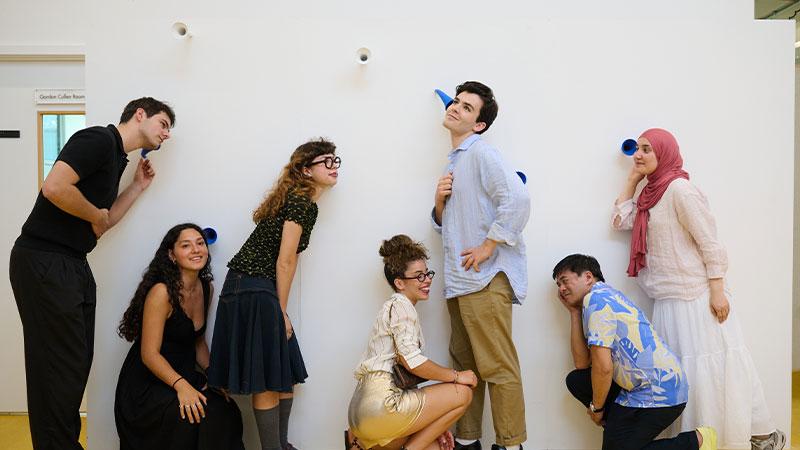The University of Westminster has opened its OPEN 2025 exhibition, where students from the School of Architecture + Cities showcase the projects they have been working on throughout the year. The exhibition celebrates the openness and diversity of Westminster’s students and includes an extensive range of creative work.

The show launched on 20 June, showcasing the ambition, creativity and experimentation found in the day-to-day life of the School. The exhibition highlights the way that students and colleagues work together to tackle the local and global issues of today.
Hosted on what turned out to be the hottest day of the year, a fitting backdrop given the School’s year-long theme, Every Fraction of a Degree Matters, the event was the first OPEN show under the leadership of new Head of School Kate Cheyne, who opened proceedings with a warm and reflective address. Emphasising the importance of design as a process rather than a finished product, she highlighted the School’s unique approach to teaching architecture - one rooted in rigorous theory, material exploration and social and environmental awareness.
Lily Thompson, Interior Architecture BA Honours student, had her work The Lines Beneath on display during the event. Her piece is an adaptive reuse scheme for London's decommissioned Aldwych Underground Station, proposing a nightclub in the eastern tunnel and compact student housing in the western tunnel. The original station building is repurposed as a museum and café, preserving historical elements while introducing contemporary interventions. The design employs strategic lighting and material treatments to balance practices of preservation and transformation.
Another piece on display is Do Androids Dream of Distant Futures by fellow Interior Architecture BA Honours student Anna Samoenko. The project combats digital isolation by blending Virtual Reality (VR) rewilding with real-world action. Users can virtually restore Barking Power Station's lost landscape, then apply their insights to physical communal gardens, fostering environmental stewardship through immersive technology.

Elena Delli Colli, Architecture BA Honours student, also showcased her project The Photographers’ Institute - a conceptual intervention at the British Library. Drawing on early 20th century theories by Moholy-Nagy and Walter Benjamin, the design features a walk-through structure that rises above the British Library roof, encouraging people to explore it through touch and movement. It is built to be taken apart and put back together, highlighting both sustainability and the changing way we share and experience knowledge.
In contrast, Architecture BA Honours student Saif Sanoufe’s work Automonument 2040 looks ahead to a possible future for Manchester’s Piccadilly Plaza, transforming a cancelled HS2 site into a new kind of public building. Inspired by the idea of skyscrapers as both symbols and working machines, Saif’s design combines a power station, data centre and community space.
Master of Architecture (MArch) RIBA Pt II students also have their work on display, including Alexandra-Clara Popescu who is showcasing her project Emptiness in the Forbidden City: Reimagining Thresholds Through a Study of Collective Resilience. The project reimagines the erased Bucharest neighbourhood of Uranus, once destroyed to make way for the Palace of Parliament. It envisions the Palace as a ruin and seeks to revive the spirit of the former community by restoring street life as an extension of gardens and homes.
The evening was officially opened by acclaimed Architect, Curator and Educator Kabage Karanja, Co-founder of the Nairobi-based studio Cave_bureau and a Westminster alumnus. Karanja spoke about Cave_bureau’s research-led practice, which explores the origins of human spatial relationships through expeditions into caves across the Great Rift Valley. His work, which spans continents and cultures, reflects a commitment to spatial justice, environmental responsibility and imaginative reinterpretation of architectural traditions.
Currently serving as a curator of the British Pavilion at the 2025 Venice Architecture Biennale and as a master jury member for the Aga Khan Awards, Karanja’s speech encouraged students to continue exploring architecture as an open-ended dialogue with the world around them.
Kate Cheyne, Head of the School of Architecture + Cities, said: "This year’s OPEN showcases our students’ outstanding work and why Westminster Architecture + Cities continues to be known as a brave and ambitious place to study Architecture and spatial design."
OPEN 2025 is part of the University’s 2025 Degree Shows, an annual celebration of talent, imagination and innovation across the University’s School of Arts, School of Architecture + Cities and School of Media and Communication. Taking place across various University of Westminster venues in London from May to July, each show spotlights the bold, diverse and future-facing work of the University’s graduating students.
OPEN 2025 will run until 11 July and directly contributes to the United Nations Sustainable Development Goals (SDG) 11: Sustainable Cities and Communities, 12: Responsible Consumption and Production and 13: Climate Action. Since 2019, the University of Westminster has used the SDGs holistically to frame strategic decisions to help students and colleagues fulfil their potential and contribute to a more sustainable, equitable and healthier society.
Find out more about the School of Architecture + Cities at the University of Westminster.








